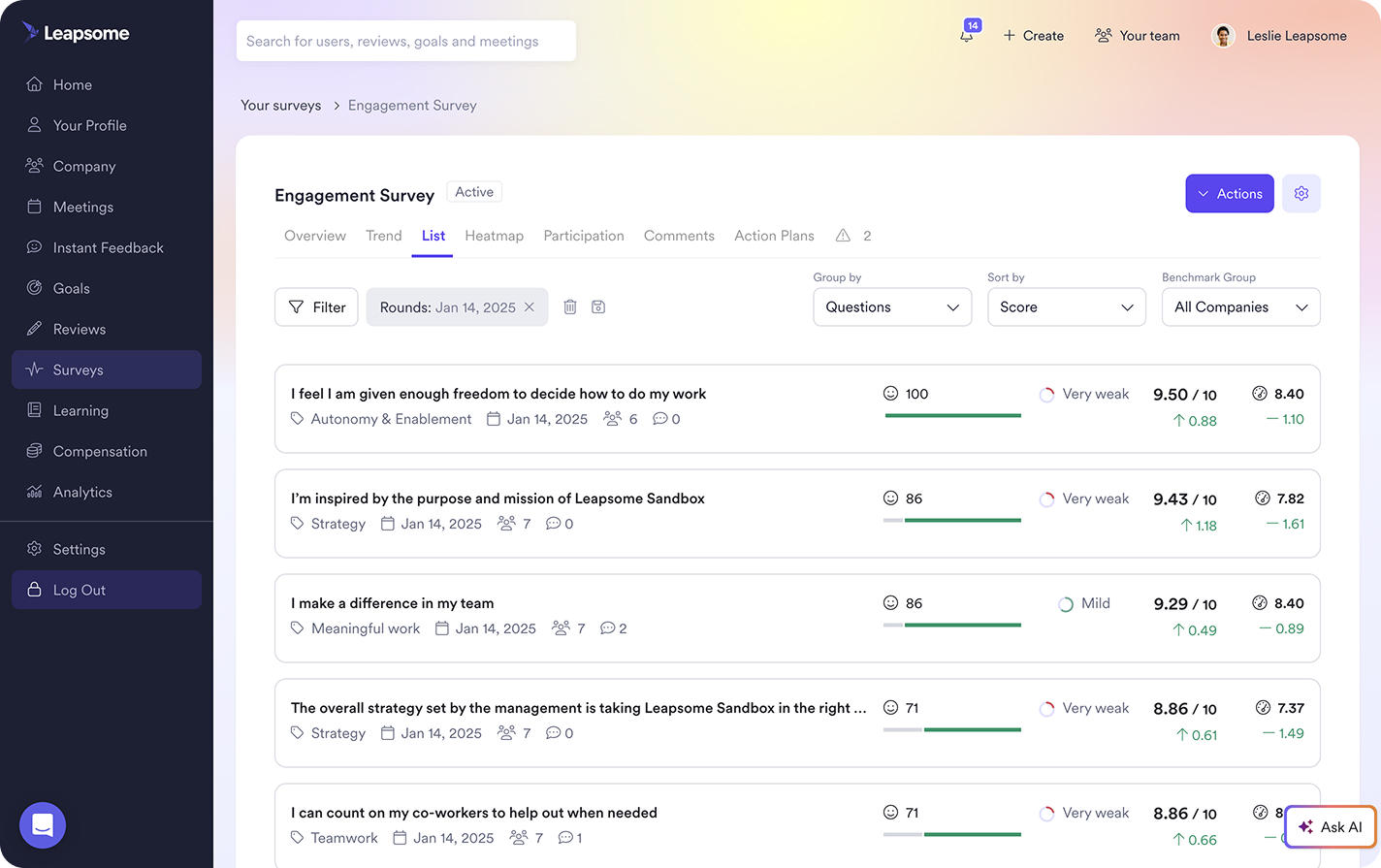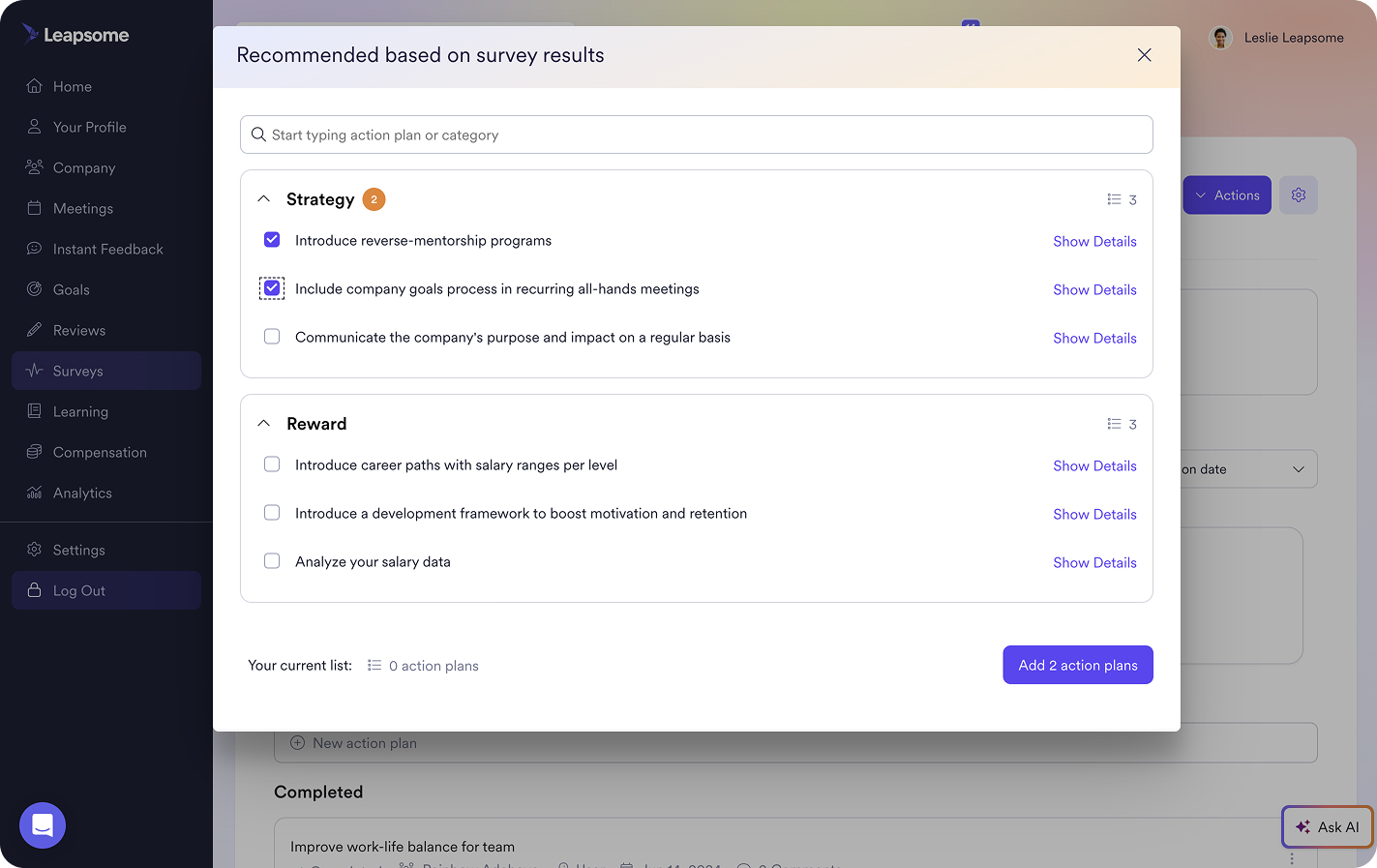.png)
TL;DR: Employee engagement ties up closely with performance, productivity, and profitability — and this means you shouldn’t overlook the potential impact of engagement survey results on a winning HR strategy. But without a solid action plan, it can be hard to show your colleagues (and business leaders) that an engagement survey is more than a compulsory exercise. With the right processes, stakeholders, and tools, your survey results can yield tangible company-wide benefits, even as employee engagement wanes worldwide.
Employee engagement survey results are the quantitative and qualitative data you receive after conducting an employee engagement survey. They support any people-centric HR strategy by allowing managers and People Ops professionals to understand how team members think, feel, and behave at work.
Conducting engagement surveys at least quarterly makes it easier to spot trends, predict employee engagement, and take action in real time.
There hasn’t been a more critical time to prioritize employee engagement data than now. Employee engagement just hit an 11-year low in the US, and sunken engagement costs the global economy an estimated US$ 9 trillion annually. While the US just avoided a major economic recession, the resulting market turmoil has impacted how employees feel about their work.
Whether you’re aware of it or not, employee engagement affects almost every area of your business. According to Gallup’s 2024 Q12® Meta-Analysis, engagement levels are directly linked to business performance. The report points to strong correlations between employee engagement and performance metrics like well-being, safety, absenteeism, work quality, customer loyalty, and productivity.
What’s more, highly engaged business units lose 43% fewer employees. Reducing turnover makes organizations more efficient; turnover costs can add up quickly, as new team members need training. The Society for Human Resource Management (SHRM) estimates that employee turnover can cost up to one-third of the departing employee’s annual salary. Other studies point to an even grimmer scenario: replacing one person could cost you up to two times their annual pay.
Considering how employee engagement affects turnover and performance, it’s no surprise that so many organizations choose to track this metric through surveys. Still, it’s not enough just to run engagement surveys: you also have to use the information you gather.
Acting on employee engagement survey analysis is critical to achieving better business outcomes and building team member trust. Employees appreciate when their concerns are listened to; those who feel heard are almost five times more likely to feel empowered to do their best work. Conversely, when team members don’t feel heard, this can quickly create an engagement problem: 64% of professionals say “leaders making decisions without seeking their input” is their biggest problem at work.
Acting on employee survey data also makes team members more willing to participate in future surveys. According to McKinsey research, the number one cause of “survey fatigue” is the perception that organizations won’t act on the results.
“Leadership is the biggest blocker to turning survey results into action. It doesn’t take a lot of money to implement change, but it does take time and commitment. Issuing the survey is the easy part, but being willing to internalize the feedback and turn it into action, for some reason, is nearly impossible for some organizations.
Before issuing the survey, leadership must commit to each other and its employees that the survey won’t be a bunch of talk, but lead to actual change.”
— Catharine Montgomery, social causes communications leader, speaking on the power of diversity surveys
So, how do you leverage survey results and use them to boost engagement? Read on to learn how to get the most from your employee surveys.
💡 Analyze survey results faster with Leapsome AI
With Leapsome’s AI-powered surveys, you can summarize survey results quickly, extract key themes, and even generate action plan recommendations.
👉 Explore what Leapsome Surveys can do for you

You can start acting on employee engagement survey results as soon as you receive them. You should use this playbook if you’ve recently completed an employee engagement survey, have pulse survey data that you’ve been aggregating over time, or intend to start running surveys.
Reviewing engagement survey results can help you deal with immediate problems and identify long-term trends. In other words, measuring engagement will allow you to pinpoint current issues and spot changes in company-wide engagement levels year over year.
To run this playbook, you’ll need an employee survey program to collect data.
If you don’t yet have a process for running surveys, or if you think your existing program could use improvement, check out our playbook on running an employee engagement survey for helpful tips on how to get started.
Your survey program should have a set of defined goals. Why are you running employee engagement surveys? What do you hope to get from them?
This will help you understand how to act on the surveys and what results you should work towards.

Before you can start turning your employee survey results into action, you must administer your surveys.
Most HR departments run surveys frequently. They might send them out weekly, monthly, or quarterly. To avoid survey fatigue, try to balance survey length and frequency; the more infrequent the survey, the more questions you can include, and vice versa.
For higher completion rates, ensure employees know when to expect a survey and send reminders to prompt them to complete it.
Remember: The strongest motivator for employee participation is a culture of acting on employee survey results. No matter how many reminders you send out, no one wants to spend time completing a survey if they think the results will be ignored.
How are you currently running employee engagement surveys? Are you using a mix of software and documents, or even administering surveys on paper? Having employee survey results scattered in different places can lead to confusion and make it more difficult to analyze the data you gather.
To stay organized and make employee engagement analysis faster, it’s useful to have a “single source of truth” for your employee survey results. With a people management platform, you can manage your survey process in one place — alongside other critical HR functions like performance management, OKRs, and learning.
💡 Looking for a survey platform that tells you what action steps to take?
Leapsome generates personalized recommendations based on your engagement survey results, so you create the right strategy for your company.
👉 Discover how Leapsome Surveys can help you

You'll have access to two types of data in your employee survey analysis: quantitative and qualitative. Quantitative data can be expressed through numbers or metrics, while qualitative data consists of more subjective, long-form answers.
The employee Net Promoter Score (eNPS) is a commonly tracked quantitative metric. Net Promoter Score is a widely used measure for tracking customer satisfaction, and eNPS applies the same metric for employee satisfaction.
You can find your eNPS using just one survey question: “On a scale of 0–10, how likely would you be to recommend our organization to a friend or colleague?” Employees may be classified as detractors (0–6), passives (7–8), or promoters (9–10), depending on the scores they give. To calculate your eNPS score, subtract the percentage of detractors from the percentage of promoters. You can also easily measure eNPS with Leapsome’s employee survey analytics.
To better understand your quantitative data, try filtering and segmenting it — for example, by age, gender, team, or job title. With Leapsome, you can also verify other companies’ benchmarks.
.jpeg)
Qualitative data is a bit more complex to analyze. When looking at someone’s long-form answer, you may be unsure what they mean by their comments. While you could ask them to elaborate in an in-person conversation, this can be difficult with anonymous surveys.
Fortunately, Leapsome lets you easily contact employee survey respondents and engage in anonymous talks.
Sentiment analysis can also help you analyze qualitative data at scale. This natural language processing (NLP) technique (which you’ll find in Leapsome!) can help you digest and visualize information by grouping comments into categories and classifying them as positive, negative, or neutral.
The next step is to look at the “big picture” of your engagement survey results. Your qualitative and quantitative analyses should have revealed key points to focus on. Once you’ve identified your company’s strengths and weaknesses, brainstorm how these might translate into an action plan.
For example, if most employees gave low scores on the statement “my manager cares about my opinions,” you could consider setting up a managerial training program. Or if the statement “I have access to the equipment and tools I need to do my job” received a low score, perhaps it’s time to upgrade your technology and infrastructure.
The ideas you come up with during this brainstorming will serve as a foundation for your action plan.

It’s time to create an action plan and decide how to move forward. This is where you’ll choose the most important points to focus on and outline the specific steps you’ll take to reach your goals.
Lay out your action plan in writing and include regular checkpoints and deadlines for accountability. Leapsome allows you to create this type of post-survey plan and assign ownership of specific projects, making it easy to keep track of your progress along the way.
To keep employees at all company levels engaged and involved, avoid simply issuing decrees from above. Consider also offering ways for employees to create change from the bottom up. For example, many companies have created working groups where employees can discuss DEI issues, express concerns, and plan future actions.
Once you’ve analyzed the data, understood it, and created your action plan, it’s time to share the survey results with your company's employees.
Decide who needs to see the survey results, data visualizations, and action plan — as well as and how they should be presented. Employee survey results should always be discussed with managers, and we recommend that you share them with employees as well (especially if you’re planning to make big changes).
You can share employee survey results at an all-hands meeting and follow up via email, recapping the action plan from the previous round and the results.
“Do an AMA [Ask Me Anything] in your all-hands meeting and get the founder up there to discuss structural changes. Get people to ask them questions in advance.
Be able to come and be vulnerable about what you’re doing, what you’re working on, and what these changes will mean in practice, and why you believe they’re important. Show that you actually care.”
— Matt Bradburn, co-founder of The People Collective, offering his insights on how to act on employee engagement survey results on the People Over Perks podcast
Employee survey results should guide the direction of your company culture over the long term.
When turning survey results into action, you may encounter goals that you can’t act upon immediately — but these long-term objectives should be integrated into your company’s overall OKRs or goal-planning framework. That way, stakeholders can hold one another accountable for making things happen.
⭐️ Don’t know where to start with employee engagement surveys? Check out this free list of 72 best-practice questions in 22 categories, complete with an infographic and a downloadable resource to make things even easier. 😉
A challenging economic climate shouldn’t stop you from investing in employee engagement — much on the contrary! In times like these, it can be tough to encourage employees to complete surveys when they’re so used to inaction. That’s why Leapsome gives you the tools to demonstrate to everyone exactly how you plan to put their feedback to use.
Our people enablement platform allows you to create a well-oiled engagement survey cycle, complete with AI-powered survey analytics and actionable insights into how your employees feel at work.
Watch this video to learn how Leapsome can help you build a better employee feedback loop.
💪 Future-proof your engagement strategy with AI-powered surveys
Automate your survey cycle with Leapsome and get access to in-depth analytics and personalized action plans so you can execute your strategy with greater agility.
👉 Book a demo

When communicating employee survey results, remember that your people appreciate transparency. If you’re planning to make major changes, discussing these with employees at a meeting may be best rather than over email. That way, employees can ask questions, share feedback, and clarify any doubts.
When sharing results, be sure to respect anonymity and privacy. Avoid sharing detailed comments that could be traced back to an individual — especially on sensitive topics.
To run an employee engagement survey, start by defining your survey goals and deciding who will participate. Then, create your employee engagement survey questions. Finally, send out the survey at regular intervals according to your preferred schedule. Don’t forget to send reminders to encourage responses!
Learn how Leapsome can automate, connect, and simplify your HR processes.
.webp)
.webp)
 Book your demo
Book your demo


Run smooth operations with our easy-to-follow how-tos and best practices for all things People Ops
Mit unseren leicht verständlichen Anleitungen und Best Practices für People Ops sorgen Sie für reibungslose Abläufe.